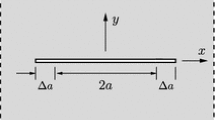Abstract
We propose a procedure of testing materials for static crack resistance for mixed modes of fracture: I + II (tension and transverse shear) and I + III (tension and longitudinal shear). Cylindrical specimens with circular or circular and lateral notches are tested under the conditions of loading by combined tension and torsion. The description of specimens is presented. The procedures of testing, determination of the force and deformation characteristics of crack resistance for the indicated loading conditions, and processing of the results in the form of crack resistance diagrams are proposed. The procedures are developed in conformity with the requirements and regulations of the national standards.
Similar content being viewed by others
REFERENCES
GOST 25.506-85. Strength Analyses and Tests. Methods for Mechanical Testing of Metals. Determination of the Characteristics of Crack Resistance (Fracture Toughness) Under Static Loading [in Russian], Izd. Standartov, Moscow (1985).
RD 50-260-81. Methodical Instructions. Strength Analyses and Tests in Machine Building. Methods for Mechanical Testing of Metals. Determination of the Characteristics of Fracture Toughness (Crack Resistance) Under Static Loading [in Russian], Izd. Standartov, Moscow (1982).
F. Erdogan and G. C. Sih, “On the crack extension in plates under plane loading and transverse shear,” Tekh. Mekh., 85, No.4, 49–59 (1963).
Ya. L. Ivanyts’kyi and A. O. Andreikiv, “State of limiting equilibrium of cracked bodies for mixed macromechanisms of fracture,” Fiz.-Khim. Mekh. Mater., 39, No.4, 12–19 (2003).
Methodical Recommendations. Strength Analyses and Tests. Methods for Mechanical Testing of Metals. Determination of the Characteristics of Crack-Growth Resistance for Mode-III Cracks [in Russian], Karpenko Physicomechanical Institute, Ukrainian Academy of Sciences, Lviv (1987).
A. A. Chizhik, “Local fracture criteria in the presence of cracks under the conditions of complex stressed state,” Energomashinostroenie, No. 10, 31–34 (1975).
V. V. Panasyuk, Mechanics of Quasibrittle Fracture of Materials [in Russian], Naukova Dumka, Kiev (1991).
V. V. Panasyuk, A. E. Andreikiv, and Ya. L. Ivanitskii, “The δIIIc criterion and its experimental realization,” Fiz.-Khim. Mekh. Mater., 20, No.5, 3–6 (1984).
DSTU 3966-2000. Terminology. Foundations and Rules of the Development of Standards for Terms and Definitions [in Ukrainian], Derzhstandart Ukrainy, Kiev (2000).
DSTU 1.2:2003. National Standardization. Regulations of the Development of National Standard Documents [in Ukrainian], Derzhstandart Ukrainy, Kiev (2003).
DSTU 1.3:2003. National Standardization. Regulations Governing the Structure, Presentation, and Execution of Standard Documents and Requirements to Their Content [in Ukrainian], Derzhstandart Ukrainy, Kiev (2003).
Author information
Authors and Affiliations
Additional information
__________
Translated from Fizyko-Khimichna Mekhanika Materialiv, Vol. 41, No. 1, pp. 97–103, January–February, 2005.
Rights and permissions
About this article
Cite this article
Ivanyts’kyi, Y.L., Shtayura, S.T. Evaluation of the Characteristics of Crack Resistance of Materials for Mixed Macromechanisms of Fracture. Mater Sci 41, 113–121 (2005). https://doi.org/10.1007/s11003-005-0139-1
Received:
Issue Date:
DOI: https://doi.org/10.1007/s11003-005-0139-1




